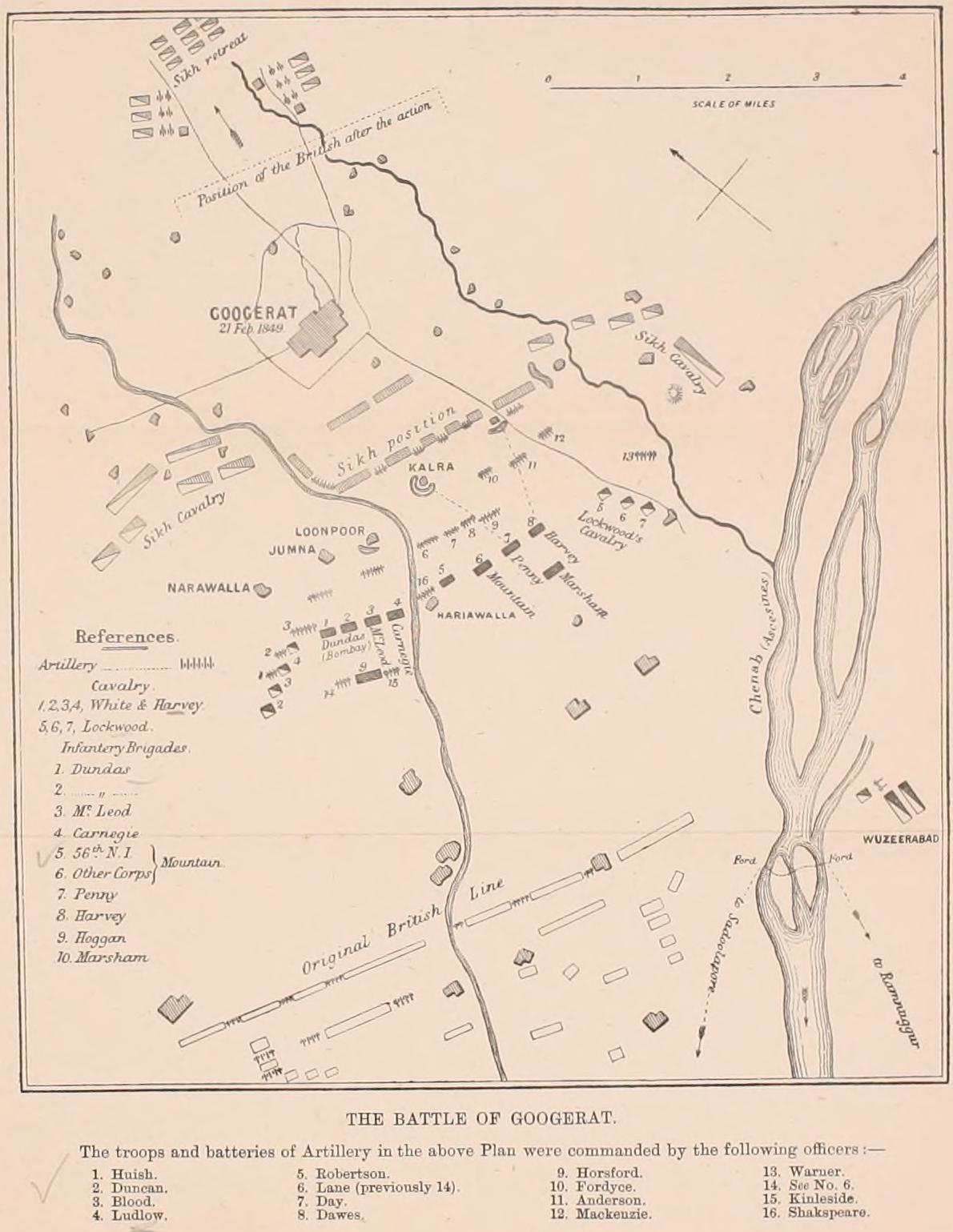|
Battle Of Gujrat
The Battle of Gujrat was a decisive battle in the Second Anglo-Sikh War, fought on 21 February 1849, between the forces of the East India Company, and a Sikh army in rebellion against the company's control of the Sikh Empire, represented by the child Maharaja Duleep Singh who was in British custody in Lahore. The Sikh army was defeated by the British regular and Bengal Army forces of the British East India Company. After it capitulated a few days later, the Punjab was annexed to the East India Company's territories and Duleep Singh was deposed. Outbreak and course of the war After the British victory in the First Anglo-Sikh War, the Punjab was indirectly governed by a British representative at the Durbar (court) in Lahore and Agents in several of the regions. The Sikh Army, the Khalsa, was kept in being and used to keep order in the Punjab and North West Frontier Region. The Khalsa regarded itself as betrayed rather than defeated in the first war, and several of its Sarda ... [...More Info...] [...Related Items...] OR: [Wikipedia] [Google] [Baidu] |
Second Anglo-Sikh War
The Second Anglo-Sikh War was a military conflict between the Sikh Empire and the East India Company which took place from 1848 to 1849. It resulted in the fall of the Sikh Empire, and the annexation of the Punjab region, Punjab and what subsequently became the North-West Frontier Province, by the East India Company. On 19 April 1848, Patrick Alexander Vans Agnew, Patrick Vans Agnew of the civil service and Lieutenant William Anderson of the Bombay European regiment, having been sent to take charge of Multan from Diwan Mulraj Chopra, were murdered there; within a short time, the Sikh troops joined in open rebellion. Governor-General of India James Broun-Ramsay, 1st Marquess of Dalhousie, Lord Dalhousie agreed with Hugh Gough, 1st Viscount Gough, Sir Hugh Gough, the commander-in-chief, that the British East India Company's military forces were neither adequately equipped with transport and supplies, nor otherwise prepared to take the field immediately. He also foresaw the spre ... [...More Info...] [...Related Items...] OR: [Wikipedia] [Google] [Baidu] |
First Anglo-Sikh War
The First Anglo-Sikh War was fought between the Sikh Empire and the British East India Company in 1845 and 1846 around the Firozpur district of Punjab. It resulted in the defeat and partial subjugation of the Sikh empire and cession of Jammu and Kashmir (princely state), Jammu & Kashmir as a separate princely state under British Paramountcy, British suzerainty. Background and causes of the war The Sikh kingdom of Punjab was expanded and consolidated by Maharajah Ranjit Singh during the early years of the nineteenth century, about the same time as the British-controlled territories were advanced by conquest or annexation to the borders of the Punjab. When shown the map of India, Maharaja Ranjit Singh said, "What does the red colour stand for?" The cartographer replied "Your Majesty, red marks the extent of British possessions." The Maharaja scanned the map with his single eye and saw nearly the whole of Hindustan except the Punjab painted red. He turned to his courtiers and ... [...More Info...] [...Related Items...] OR: [Wikipedia] [Google] [Baidu] |
The Battle Of Goojerat, On The 21st February 1849 - Christie's 2013 CSK 09540 0147
''The'' is a grammatical article in English, denoting nouns that are already or about to be mentioned, under discussion, implied or otherwise presumed familiar to listeners, readers, or speakers. It is the definite article in English. ''The'' is the most frequently used word in the English language; studies and analyses of texts have found it to account for seven percent of all printed English-language words. It is derived from gendered articles in Old English which combined in Middle English and now has a single form used with nouns of any gender. The word can be used with both singular and plural nouns, and with a noun that starts with any letter. This is different from many other languages, which have different forms of the definite article for different genders or numbers. Pronunciation In most dialects, "the" is pronounced as (with the voiced dental fricative followed by a schwa) when followed by a consonant sound, and as (homophone of the archaic pronoun ''thee'' ... [...More Info...] [...Related Items...] OR: [Wikipedia] [Google] [Baidu] |
Jhelum River
The Jhelum River is a major river in South Asia, flowing through India and Pakistan, and is the westernmost of the five major rivers of the Punjab region. It originates at Verinag and flows through the Indian-administered territory of Jammu and Kashmir, into Pakistan-administered Kashmir, then the Pakistani province of Punjab. It is a tributary of the Chenab River and has a total length of about . Etymology A Pakistani author, Anjum Sultan Shahbaz, recorded some stories of the name Jhelum in his book ''Tareekh-e-Jhelum'': The Sanskrit name for the river is ''Vitástā'', derived from an apocryphal legend regarding the origin of the river in the Nilamata Purana. The name survives in the Kashmiri name for this river, ''Vyath'' and in Punjabi (and more commonly in Saraiki) as ''Vehat''. It was called the Hydaspes by the armies of Alexander the Great. History The river Jhelum was originally recognized by the name Vitasta. The river was called ''Hydaspes'' () by the ancie ... [...More Info...] [...Related Items...] OR: [Wikipedia] [Google] [Baidu] |
Battle Of Chillianwala
The Battle of Chillianwala (also spelled Chillianwallah) was fought in January 1849 during the Second Anglo-Sikh war in the Chillianwala region ( Mandi Bahauddin) of Punjab, now part of Pakistan. The battle was one of the bloodiest fought by the British East India Company. Both armies held their positions at the end of the battle and both sides claimed victory.Heath, p.42 The battle was a strategic check to immediate British ambitions in India and a shock to British military prestige.Major A. H. Amin (retd.) Orbat.com Background The broke out in the Punjab, which had recently lost much of its independence to th ...[...More Info...] [...Related Items...] OR: [Wikipedia] [Google] [Baidu] |
Battle Of Ramnagar
The Battle of Ramnagar (sometimes referred to as the Battle of Rumnuggur) was fought on 22 November 1848 between British East India Company and Sikh Empire forces during the Second Anglo-Sikh War. The British were led by Sir Hugh Gough, while the Sikhs were led by Raja Sher Singh Attariwalla. The Sikhs repelled an attempted British surprise attack. Background Following the Sikh defeat in the First Anglo-Sikh War, British Commissioners and Political Agents had effectively ruled the Punjab, using the Sikh Khalsa Army to maintain order and implement British policy. There was much unrest over this arrangement and the other galling terms of the peace treaty, not least within the Khalsa which believed it had been betrayed rather than defeated in the first war. The second war broke out in April 1848, when a popular uprising in the city of Multan forced its ruler, Dewan Mulraj, into rebellion. The British Governor-General of Bengal, Lord Dalhousie, initially ordered only a small c ... [...More Info...] [...Related Items...] OR: [Wikipedia] [Google] [Baidu] |
Chenab River
The Chenab River is a major river in India and Pakistan, and is one of the 5 major rivers of the Punjab region. It is formed by the union of two headwaters, the Chandra and Bhaga, which rise in the upper Himalayas in the Lahaul region of Himachal Pradesh, India. The Chenab flows then through the Jammu region of Jammu and Kashmir, India into the plains of Punjab, Pakistan, where it joins the Sutlej River to form the Panjnad, which ultimately flows into the Indus River at Mithankot. The waters of the Chenab were allocated to Pakistan under the terms of the Indus Waters Treaty. India is allowed non-consumptive uses such as power generation. The Chenab River is extensively used in Pakistan for irrigation. Its waters are also transferred to the channel of the Ravi River via numerous link canals. Name The Chenab river was called ' () in the Rigveda (VIII.20.25, X.75.5). The name meant that it was seen to have dark-coloured waters. The term Krishana is also found in the At ... [...More Info...] [...Related Items...] OR: [Wikipedia] [Google] [Baidu] |
James Broun-Ramsay, 1st Marquess Of Dalhousie
James Andrew Broun-Ramsay, 1st Marquess of Dalhousie (22 April 1812 – 19 December 1860), known as the Earl of Dalhousie between 1838 and 1849, was a Scottish statesman and colonial administrator in British India. He served as Governor-General of India from 1848 to 1856. He established the foundations of the colonial educational system in India by adding mass education in addition to elite higher education. He introduced passenger trains to the Rail transport in India#History, railways, the electric telegraph and uniform postage, which he described as the "three great engines of social improvement". He also founded the Central Public Works Department, Public Works Department in India. He stands out as the far-sighted Governor-General who consolidated East India Company rule in India, laid the foundations of its later administration, and by his sound policy enabled his successors to stem the tide of rebellion. His period of rule in India directly preceded the transformation ... [...More Info...] [...Related Items...] OR: [Wikipedia] [Google] [Baidu] |
Monsoon
A monsoon () is traditionally a seasonal reversing wind accompanied by corresponding changes in precipitation but is now used to describe seasonal changes in Atmosphere of Earth, atmospheric circulation and precipitation associated with annual latitudinal oscillation of the Intertropical Convergence Zone (ITCZ) between its limits to the north and south of the equator. Usually, the term monsoon is used to refer to the Wet season, rainy phase of a seasonally changing pattern, although technically there is also a dry phase. The term is also sometimes used to describe locally heavy but short-term rains. The major monsoon systems of the world consist of the Monsoon#Africa (West African and Southeast African), West African, Asian–Australian monsoon, Australian, the North American monsoon, North American, and South American monsoons. The term was first Glossary of the British Raj, used in English in British India and neighboring countries to refer to the big seasonal winds blowin ... [...More Info...] [...Related Items...] OR: [Wikipedia] [Google] [Baidu] |
Dewan Mulraj
Mulraj Chopra (1814 – 11 August 1851) was a Sikh Empire-era administrator who served as the governor ( Diwan) of Multan from 1844 to 1849. He is known for being the leader of a Sikh rebellion against the British which led to the Second Anglo-Sikh War.Bobby Singh Bansal, Remnants of the Sikh Empire: Historical Sikh Monuments in India & Pakistan, Hay House, Inc, 1 Dec 2015 Early life Mulraj Chopra was born to Diwan Sawan Mal, a Punjabi Khatri. His father Sawan Mal had attained distinction by capturing Multan from the Afghans and was made its Diwan by Ranjit Singh, the Maharaja of the Sikh Empire. On his father's death, Mulraj succeeded him as the Diwan of Multan. The Sikh Revolt One of the first acts of the new British Resident in Lahore, Sir Frederick Currie, was to raise taxes. This move caused widespread resentment, particularly in Multan, where Mulraj had remained steadfastly loyal to Ranjit Singh and his family. To counter the resentment, British officials sought to repla ... [...More Info...] [...Related Items...] OR: [Wikipedia] [Google] [Baidu] |
Patrick Alexander Vans Agnew
Patrick Alexander Vans Agnew (22 April 1822 – 21 April 1848) was a British civil servant of the East India Company, whose murder in April 1848 during the Siege of Multan by the retainers of Dewan Mulraj led to the Second Sikh War and to the British annexation of the Punjab region. Background Vans Agnew was born on the 22nd of April 1822 and was the second son of Lieutenant-Colonel Patrick Vans Agnew, a Madras officer of considerable reputation, and afterwards a director of the East India Company. India After a very successful career at Haileybury College, where he gave evidence of superior talent and of judgment and force of character in advance of his years, Agnew joined the Bengal civil service in March 1841, and in the following year commenced his official life as assistant to the commissioner of the Delhi division. In December 1845 he was appointed assistant to Major George Broadfoot, the superintendent of the Cis-Sutlej states, and was present at the Battle of Sobra ... [...More Info...] [...Related Items...] OR: [Wikipedia] [Google] [Baidu] |
Multan
Multan is the List of cities in Punjab, Pakistan by population, fifth-most populous city in the Punjab, Pakistan, Punjab province of Pakistan. Located along the eastern bank of the Chenab River, it is the List of cities in Pakistan by population, sixth-largest city in the country; and serves as the administrative headquarters of its Multan Division, eponymous division and Multan District, district. A major cultural, religious and economic centre of the Punjab, Punjab region, Multan is one of the List of oldest continuously inhabited cities#Asia, oldest inhabited cities of Asia, with a history stretching deep into antiquity. Multan was part of the Achaemenid Empire of Iran in the early 6th century BC. The ancient city was besieged by Alexander the Great during the Mallian campaign. Later it was conquered by the Umayyad military commander Muhammad bin Qasim in 712 CE after the conquest of Sindh. In the 9th century, it became capital of the Emirate of Multan. The region came under ... [...More Info...] [...Related Items...] OR: [Wikipedia] [Google] [Baidu] |










